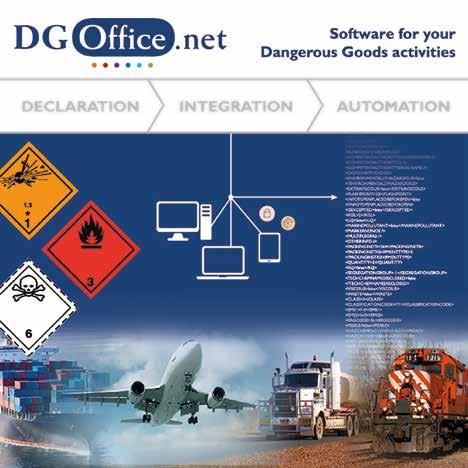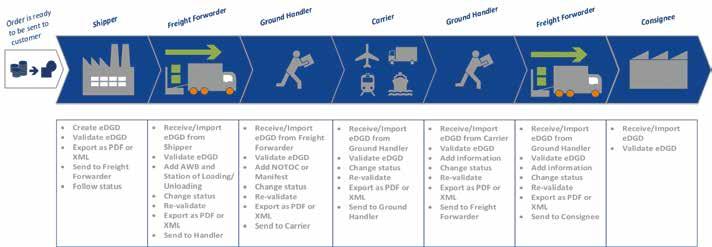
5 minute read
DGOffice updates XML standards
FLY BY WIRELESS
E-FREIGHT • ELECTRONIC DOCUMENTATION OFFERS TO IMPROVE SPEED AND ACCURACY IN THE TRANSPORT CHAIN BUT, AS DGOFFICE REPORTS, STANDARDS ARE VITAL
THE INTERNATIONAL SHIPMENT of goods by different modes of transport generates a lot of paperwork. When such shipments involve dangerous goods, the volume of documentation is multiplied. There are strict regulations and procedures to be observed and many parties involved – shippers, forwarders, (ground) handlers, carriers and consignees, and potentially others. All those parties play a distinct role and need access to certain information if they are to perform their activities properly. The information accompanying the shipment needs to be available to all parties involved in the transport chain, but not necessarily at the same time as the goods themselves and not necessarily in the same format.
In the past, it has been common for each player in the transport chain to generate its own documentation. This has meant re-keying the data, with each step along the chain raising the possibility that errors will creep in. Experience shows that, for general goods, as many as 87 repetitions are possible – and, with dangerous goods, the number is even greater. This adds to complexity, wastes time and can easily introduce errors.
APPLYING TECHNOLOGY There have been many attempts to leverage emerging technologies to ameliorate this problem, going back at least 30 years. Recent innovations and developments by specialists such as DGOffice.net have meant that the need for each participant in the dangerous goods supply chain to re-key information has disappeared. And, while information still needs to be shared with other parties in the shipping process, the exchange of hard-copy paperwork is redundant, especially as regulators open up the documentation requirements to electronic copies and signatures.
This is leading to developments that focus on streamlining data sharing in such a way that it is beneficial and convenient for all parties involved in a shipment: systems that can support the exchange of information without the need for data to be re-entered.
DGOffice.net launched its dangerous goods data sharing standard, DGXML, publicly available under shared commons at www.dgm-sdg.com/dgxml, in July 2018 to implement an e-freight solution. This online software package automatically reproduces information and allows the data to be copied into the relevant places on each document or label that is required along the supply chain. This saves a lot of time and simultaneously removes the potential for errors to be made.
Only six months later, DGOffice.net is now handling some 32,000 multimodal webservice requests per day, and demand for the service is spreading rapidly. Users themselves are pushing automation in data transmission along their supply chains, bringing more and more parties into the e-freight club.
FAIR EXCHANGE As a result of this growing demand, new projects are being initiated. DGOffice BV participates in several of these electronic data exchange projects, providing specific input on dangerous goods information requirements. One significant outcome of this work will be a new version of DGXML, due for release early
in 2019. This will be a version-controlled XML standard for use with any mode of transport, including multimodal shipments.
The aim of this work is to create a whole multimodal collaborative platform for dangerous goods shipments, through which all relevant data can be exchanged securely between relevant parties at the click of a button. DGOffice.net can function in this way through its e-freight solution, which enables users to distribute shipment information to other parties using DGOffice.net or external systems via an export as DGXML or IATA XML. As well as this, it is possible to import, validate, edit and re-validate XML messages received from parties outside DGOffice.net.
As shippers demand better management and greater visibility in the transport chain, the status of exported shipments is displayed in DGOffice.net. Each party in a specific transport chain, from consignor to consignee and all points in between, can access the validated information, which is automatically re-used where applicable.
In addition, there are build-in solutions that have been largely developed by or for forwarders. These solutions display all declarations that are sent to them by shippers using DGOffice.net. The status of a shipment can be changed by adding an AWB or station of loading/unloading. Updated declarations can be exported and sent to ground handlers and carriers, which can in turn update the information within the same process. MOVE AWAY FROM PAPER Recently, the first electronic Dangerous Goods Declaration (e-DGD) shipment was handled by Lufthansa Cargo in Frankfurt, Germany. Together with its project partner DGOffice. net, Lufthansa Cargo is now involved in a programme to test the implementation of the e-DGD, in which shippers are invited to share their experience in its application via the DGOffice.net e-freight solution. This project started in November 2018 and is due to end in the first quarter of 2019.
Another industry initiative is a digital logistics platform developed by efreight AG, based in Switzerland. This platform is based on a communication and transaction hub that allows the digital (i.e. paperless) and secure handling and monitoring of shipments by all modes of transport. By using this platform, connected users can communicate or exchange transport data and all manner of electronic documents through corresponding interfaces. The efreight AG platform cooperates with DGOffice.net for shipments that contain dangerous goods, generating e-DGDs via the online software program that can be added directly to the consignment data on the efreight AG platform.
COMPLIANCE ENSURED The digitisation of dangerous goods documentation will have another positive benefit for industry: it will be easier to keep up to date with regulatory changes and ensure that documentation remains compliant throughout the supply chain. Regulatory change is something that all those active in the dangerous goods supply chain have to face every two years, as they have done this month.
During November 2018, Labeline International, in cooperation with HCB, held two one-day seminars in the UK to help raise awareness of the upcoming regulatory changes (see page46). At those events, speakers highlighted IATA’s decision to made the electronic air waybill (e-AWB) the default document for all air cargo shipments. This is yet another example of how the digitisation of freight documentation is becoming the norm, with the air mode in the vanguard.
DGOffice BV develops and maintains the DGOffice.net online system, web services and databases. DGOffice.net has a modular design, which means that each user sees and applies only those modules that are relevant. The core component covers all basic tools, with other modules being added as needed; if there are any changes to a user’s requirements, adjustments can be made very easily.
DGOffice BV’s products are marketed via resellers located around the world. In addition, the company is active in the dangerous goods sector in terms of the provision of complementary services such as training, packing, consulting and labelling. A free demo of DGOffice.net is available through the company’s website, www.dgoffice.net. HCB











